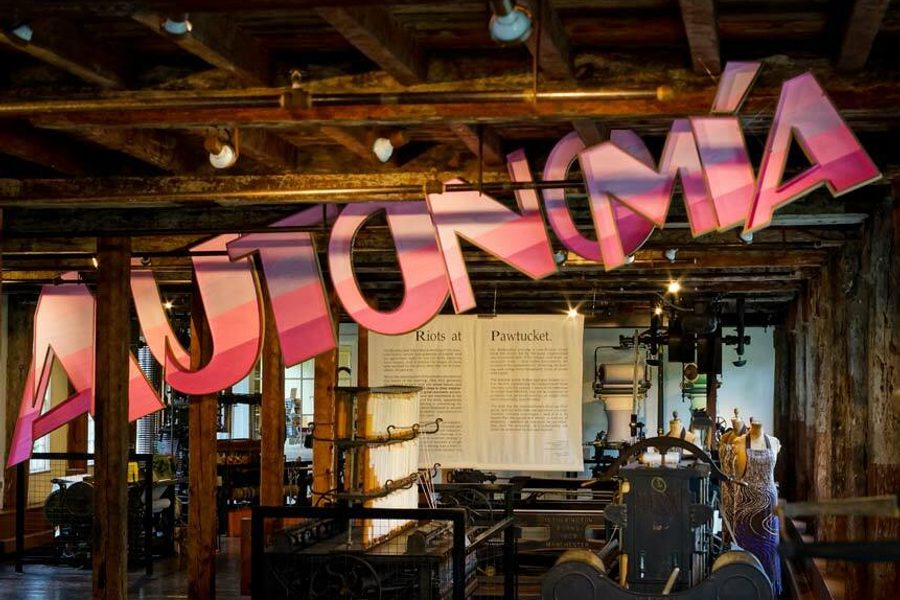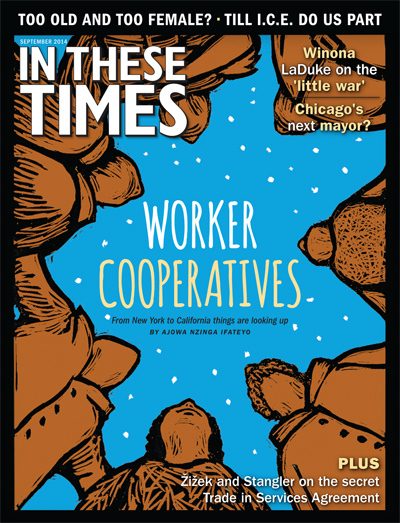Labor History: The First Factory Strike
In 1824 in Pawtucket, R.I., women weavers led the mother of all strikes.
Joey L. DeFrancesco and David Segal

In May 1824, 102 women workers in Pawtucket, Rhode Island, left their looms after the mill’s owners announced a wage cut. The workers voted to refuse to return until their old wages were restored. Then, they united with other factory workers — children and some groups of men — as well as local farmers and artisans who joined the cause. Soon, workers at nearly every one of the village’s eight mills were on strike, physically blocking doors so that no one else could enter. For a week, the village descended into chaos. Workers and farmers marched en masse to the mill owners’ houses, hurling rocks and insults. It was the first factory strike in the United States and the first strike of any kind involving women.
The Slater Mill, which employed some of the strikers, is now a national landmark and museum, and a new hybrid art/history exhibit there—The Mother of All Strikes: The 1824 Textile Worker Turnout—focuses on that week-long walkout.
Built in 1793, Slater Mill was the first textile factory in the United States. Over the next few decades, dozens more mills were built in Pawtucket, and the town played a key role in the maturation of U.S. industrial capitalism. The mill instituted innovative systems for controlling workers: highly regimented factory time (whereby work hours were counted down to the minute), factory bells and a company store.
The immediate cause of the “turn-out,” as the strike was then called, was a decision by Pawtucket’s mill owners to cut female mill workers’ wages by 25 percent and extend the working day by one hour for all workers. But resentment of the mill owners had been building for years, not just among mill workers but among other townspeople as well. Even before the first mill was built, Pawtucket residents tried to sabotage the construction of the dams that would power the factories. They were suspicious of the wealthy outsiders buying up huge pieces of land and making massive changes to the landscape. Tension mounted over the next decade, as the mill owners called on taxpayers to bankroll local projects that mostly benefited the mills.
Women joined the workforces of Pawtucket’s mills in the early 1820s with the introduction of the power loom, which allowed manufacturers to weave finished cloth by machine. Previously, young children had served as the primary mill operatives, but these new machines required an older, more skilled labor force, so the mill owners brought in the next cheapest source of labor: young women, usually between the ages of 15 and 30. What the bosses failed to foresee was that the women workers could not be as easily controlled as the children. They quickly united to take on management directly and collectively. Shocked by the display of unprecedented collective action, the mill’s owners caved in just over a week, presumably reaching a compromise that restored wages to at least close to what they had been, though the exact details of the arrangement are unknown.
Over the next few decades, the Pawtucket strikes inspired similar militant labor actions throughout New England, crescendoing in a governance crisis spurred by a statewide uprising known as the Dorr Rebellion, during which thousands of Rhode Islanders voted in favor of a new constitution that extended suffrage and created a short-lived shadow government that challenged the legitimacy of the standing state.
Slater Mill’s exhibit tells the story of the strike and its aftermath, which included a fierce crackdown by mill owners, who introduced even more draconian management styles, created police departments, and encouraged religion and temperance societies as a means of strengthening the “moral machinery” of mill cities. But the exhibit also takes a long view, using conceptual works to explore the psychological toll of the workforce control measures developed during this period and to trace their legacy to the present day. Alongside historical artifacts are contemporary artistic interpretations of the material, such as Ian G. Cozzen’s set of massive pink letters staggered throughout the factory, which spell out the word “Autonomía” only when viewed from a particular corner of the room, disrupting the factory’s regime of discipline. Kristina Brown’s “The Selvage” is a mixed-media work depicting women workers ensnared in the rigidity of factory time and scheduling. Chelsea Carl’s “it’s illegal to commit suicide” connects the 1824 strike to the present, relying on text to relate the factory floor layout to modern social justice issues.
In Rhode Island today, women workers are still at the forefront of the labor movement because they’re still the most heavily exploited workers. Providence’s hotel housekeepers, who are almost entirely women — many of whom live in more affordable Pawtucket — are leading an effort to raise their wages to $15 an hour. The exhibit serves as a reminder that 190 years ago a small group of workers could lead an entire village in challenging the will of the ruling class.
Joey L DeFrancesco is an organizer, artist and musician based in Providence, RI. He is a program developer and interpreter at the Slater Mill museum. He recently created the museum’s labor history program and curated the exhibit The Mother of All Strikes: The Textile Worker Turnout of 1824.
David Segalis the executive director of Demand Progress, and a visiting fellow at the Yale Information Society Project. He is a former Rhode Island state representative and a former member of the Providence City Council.





